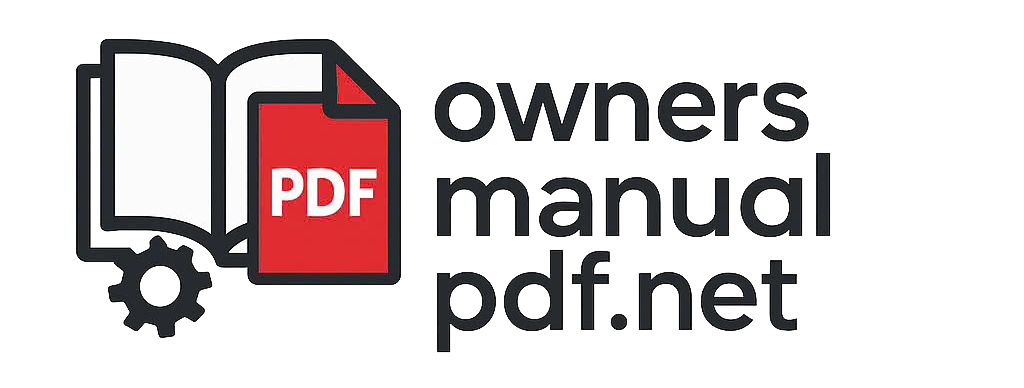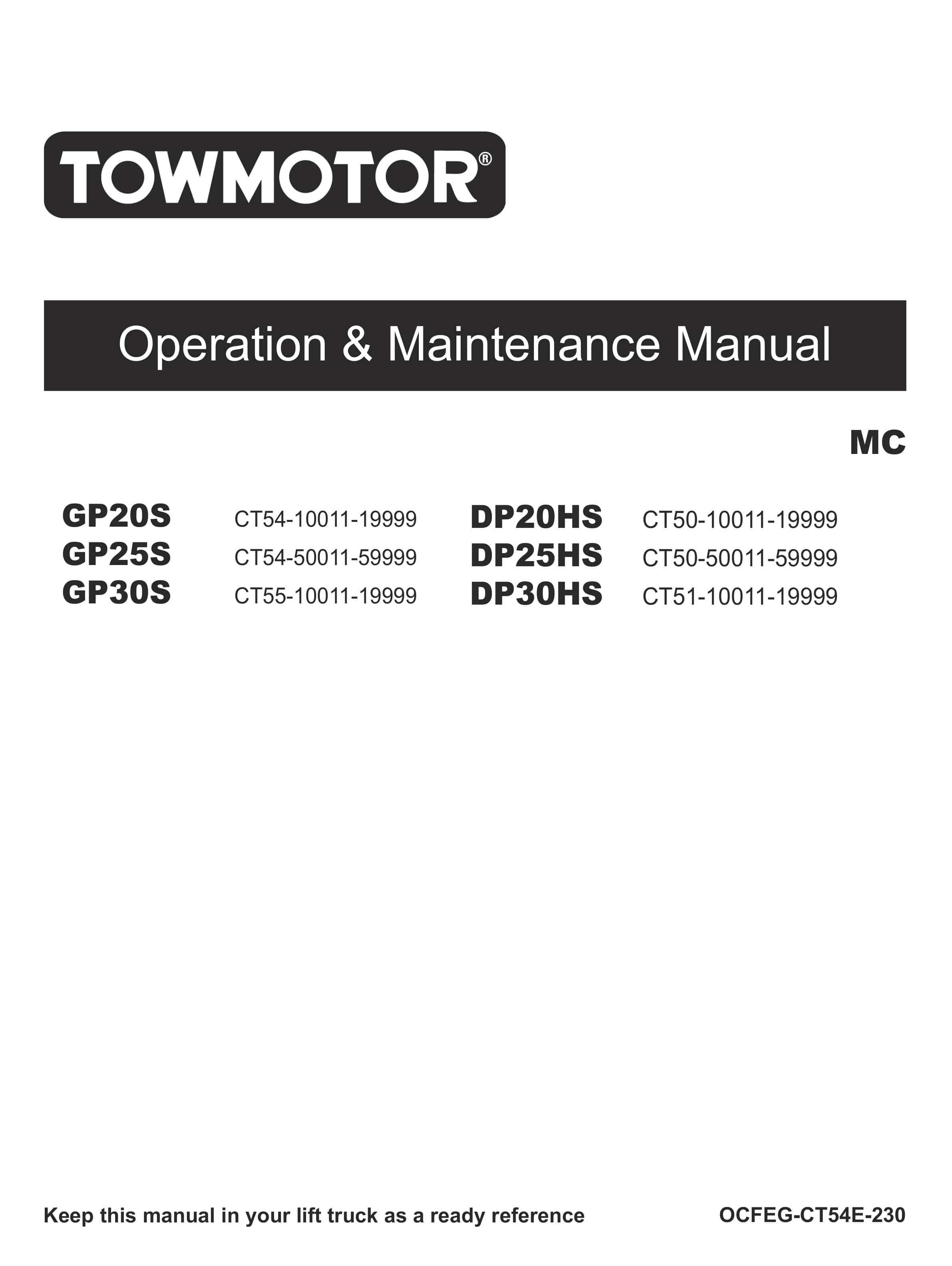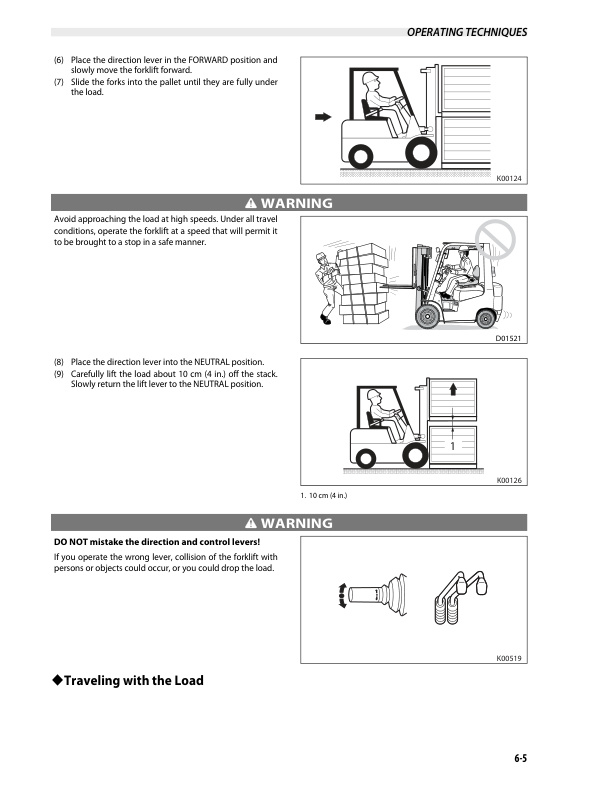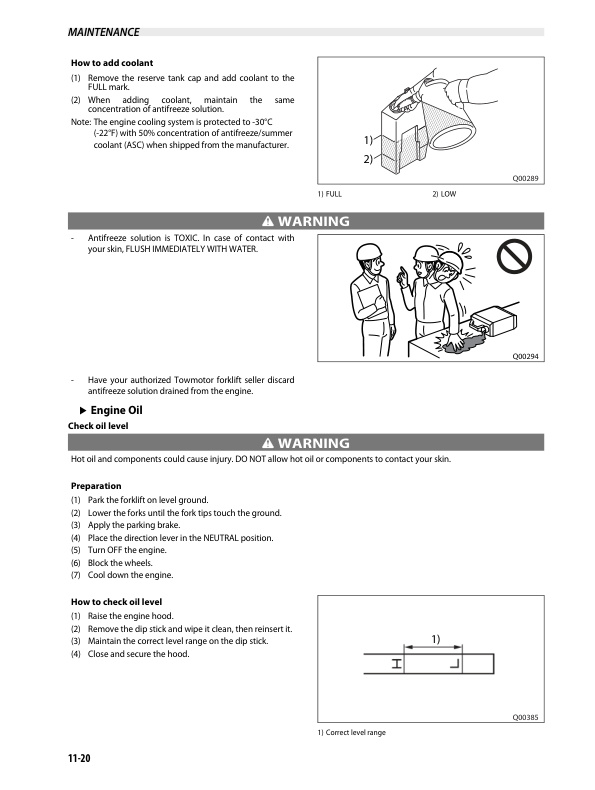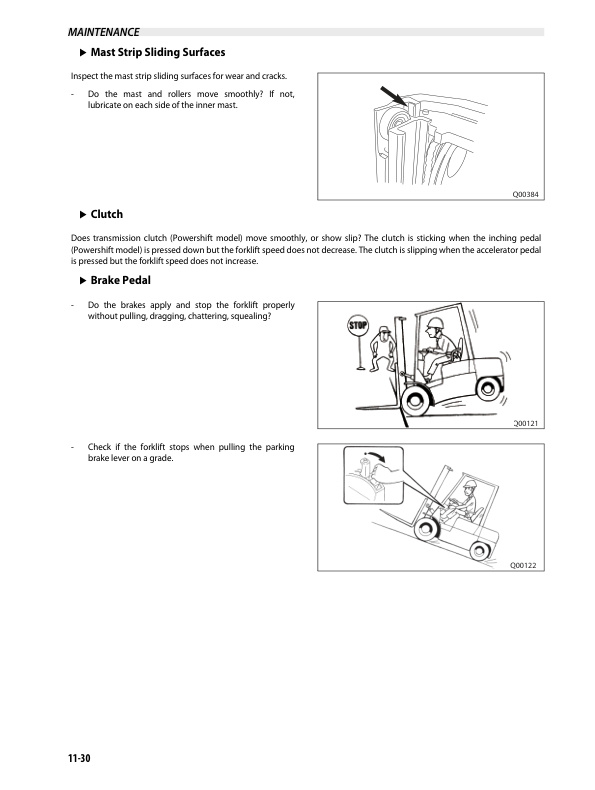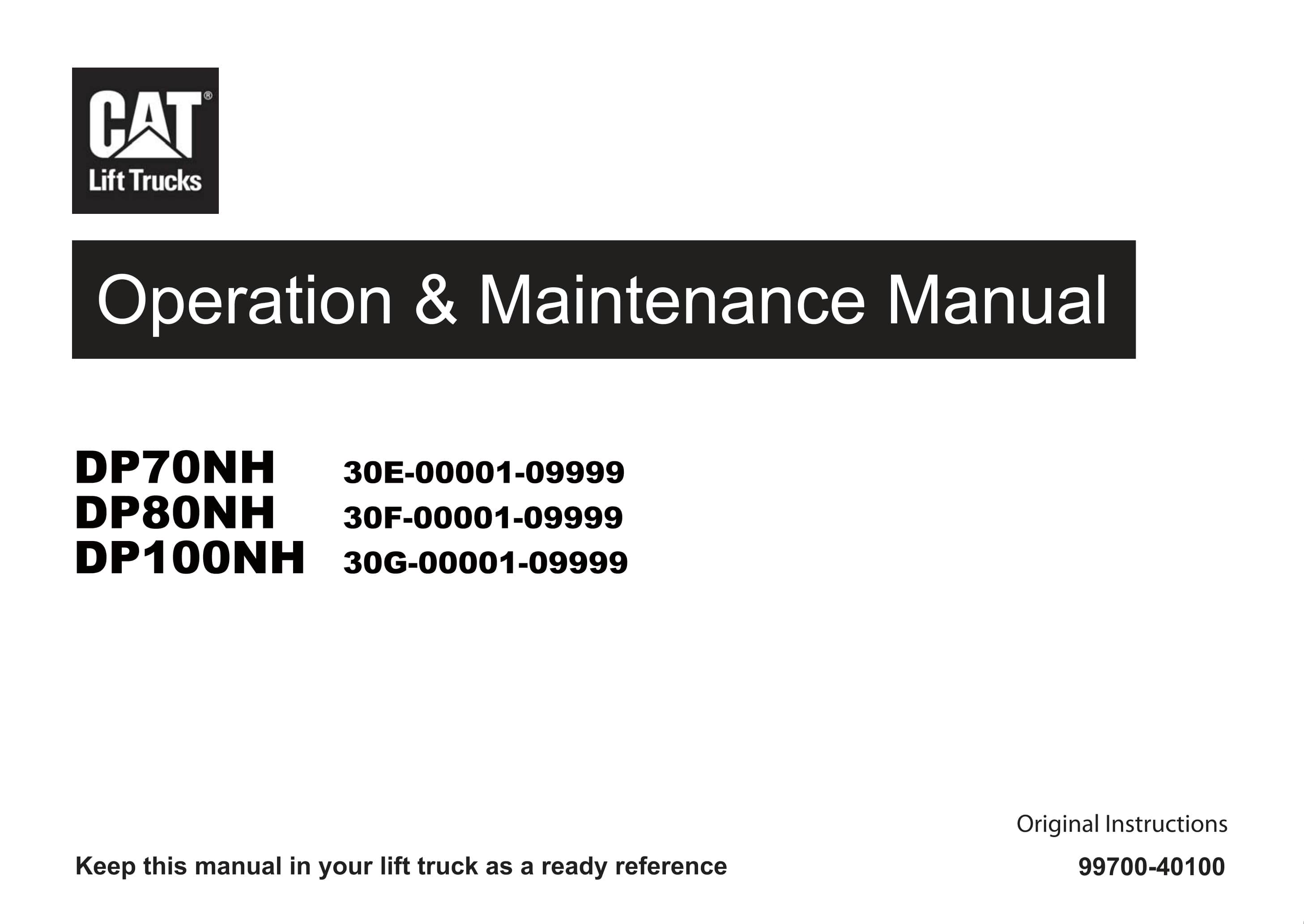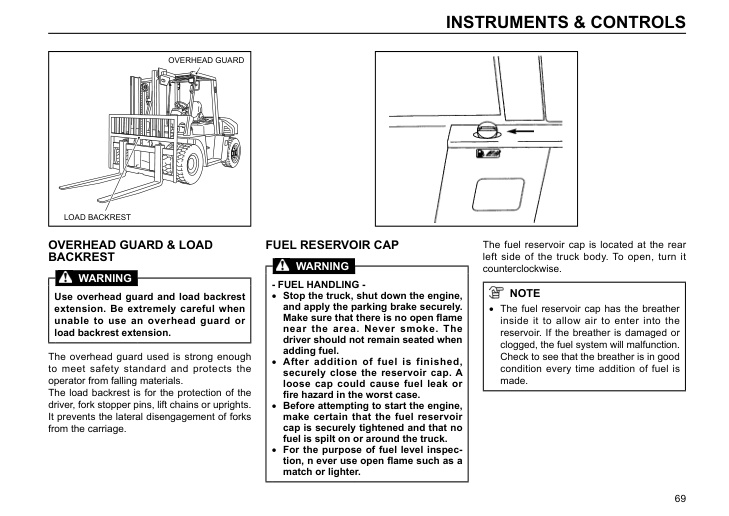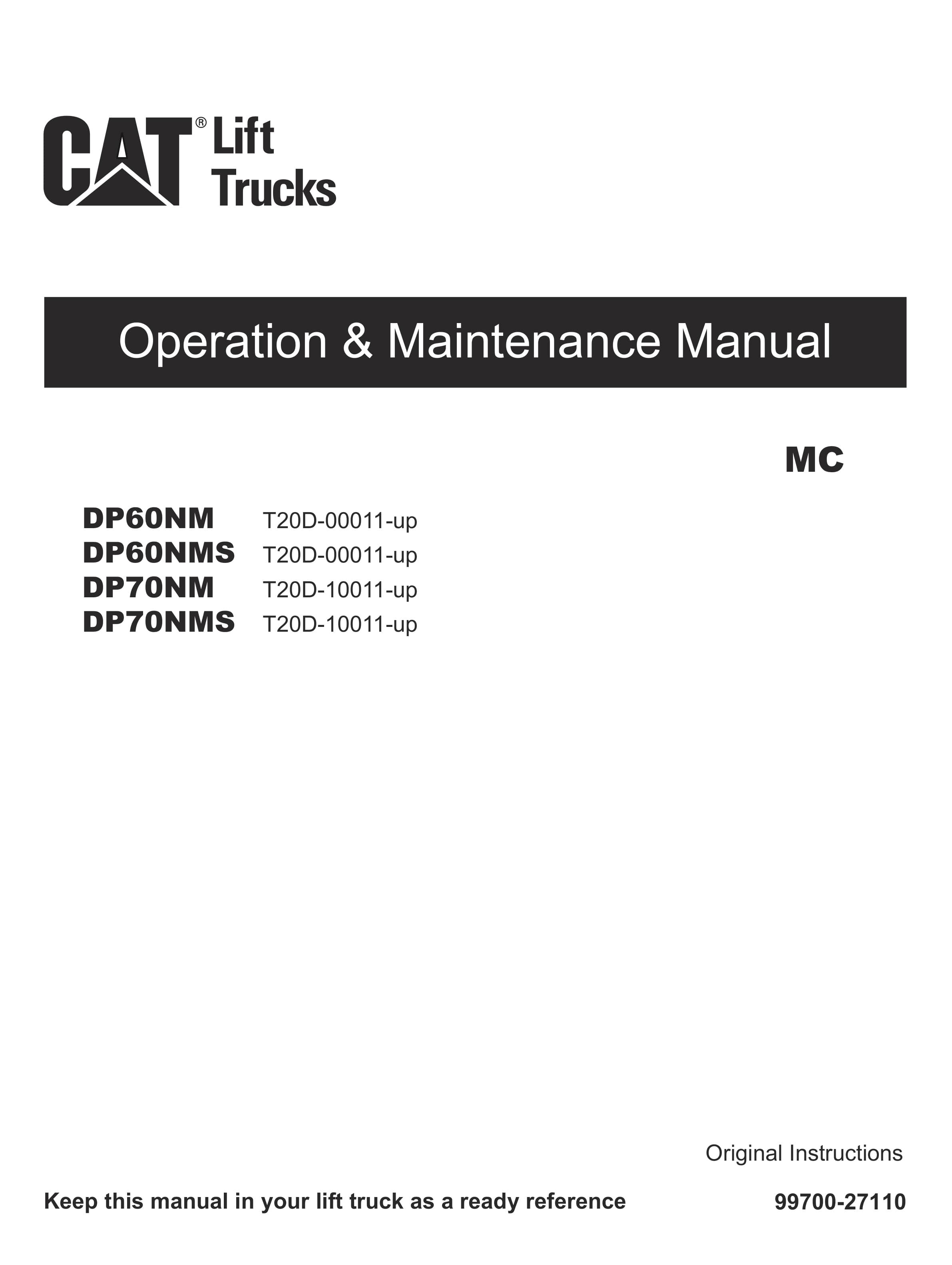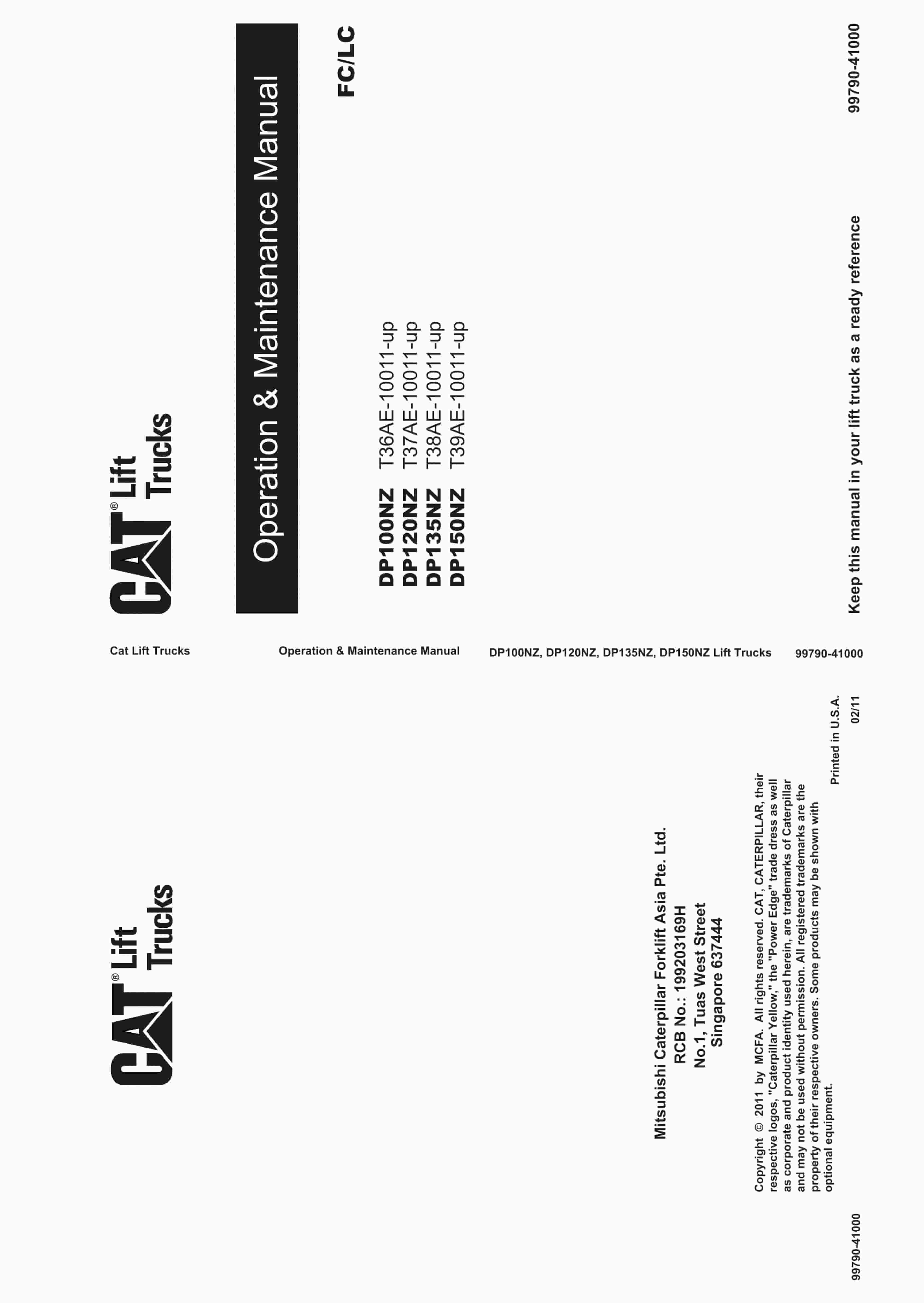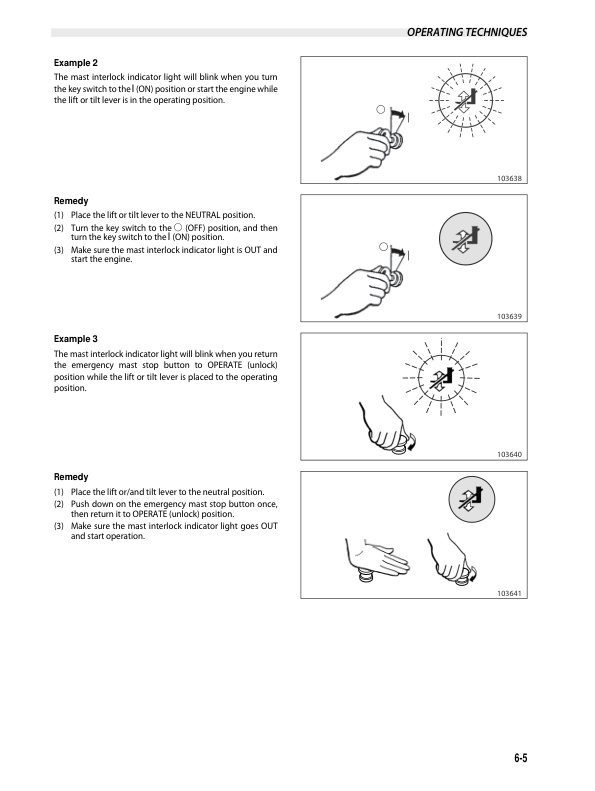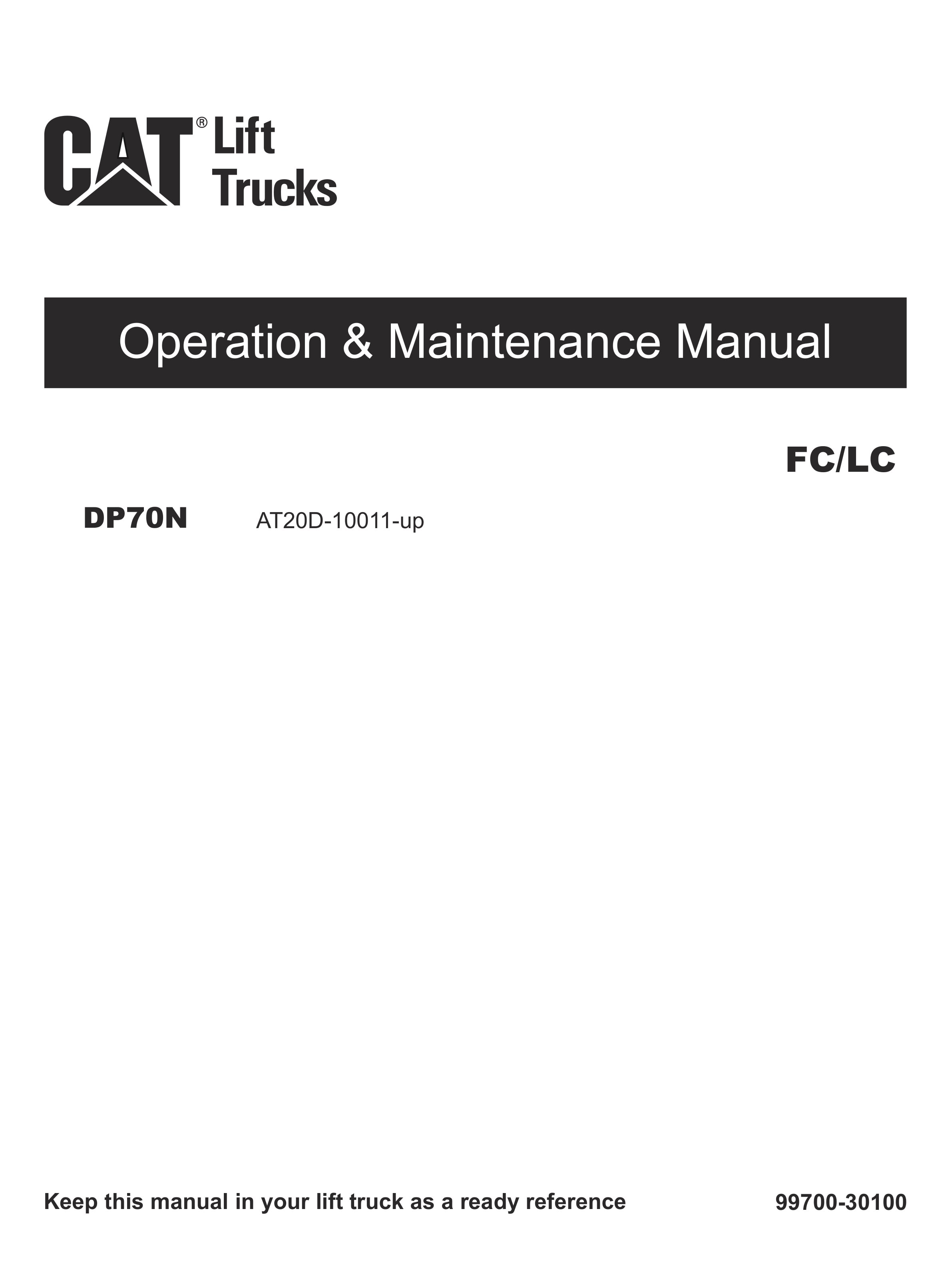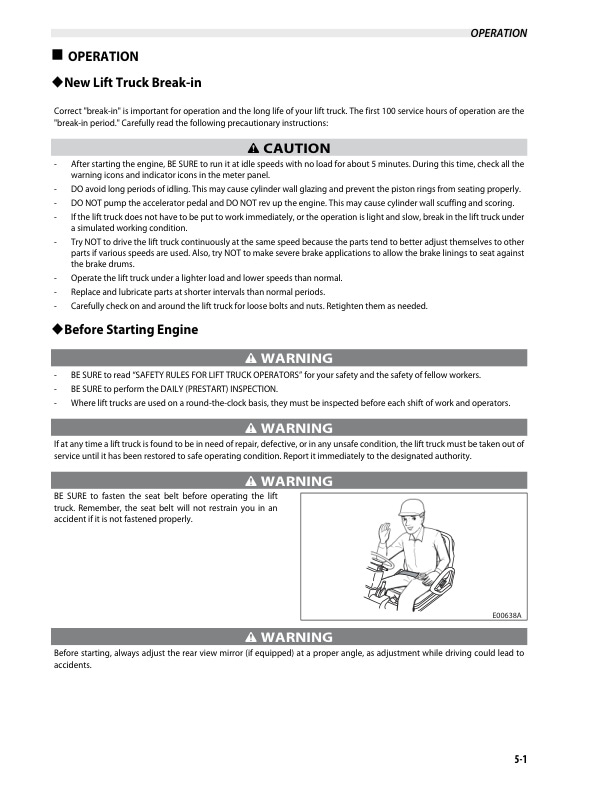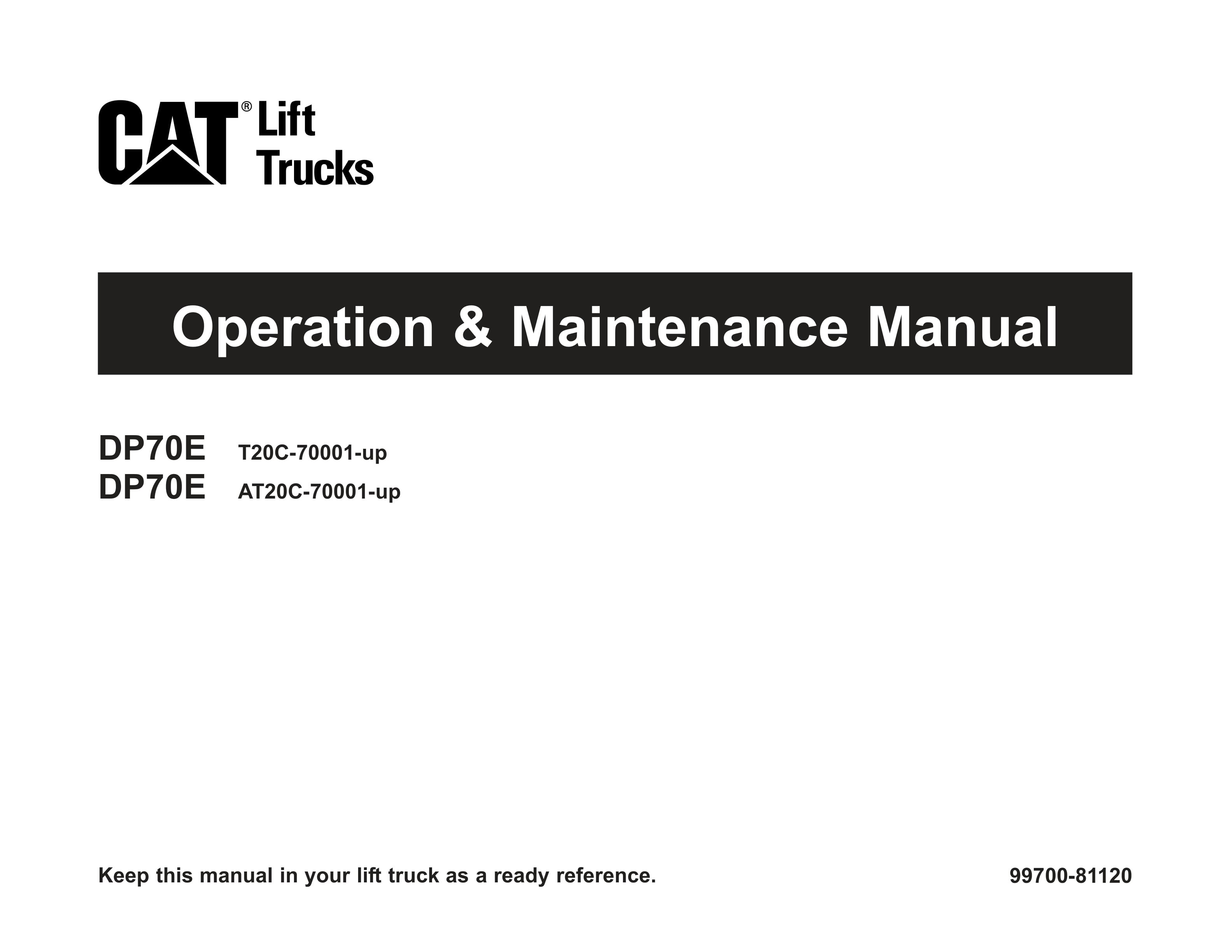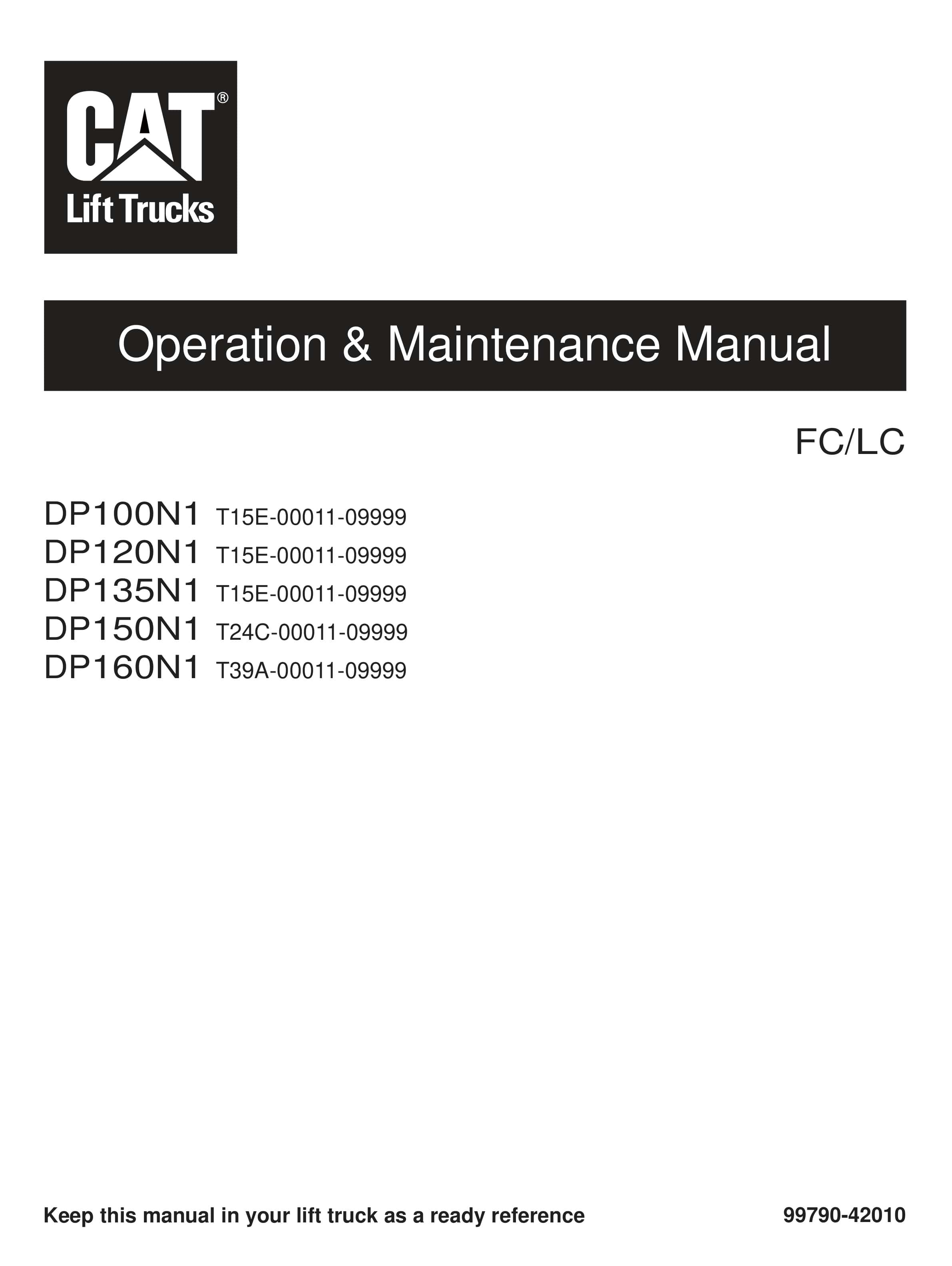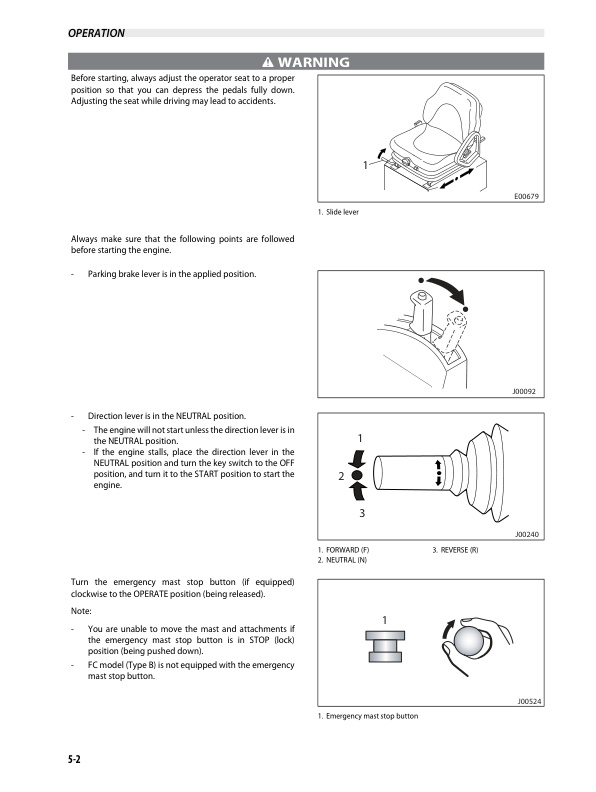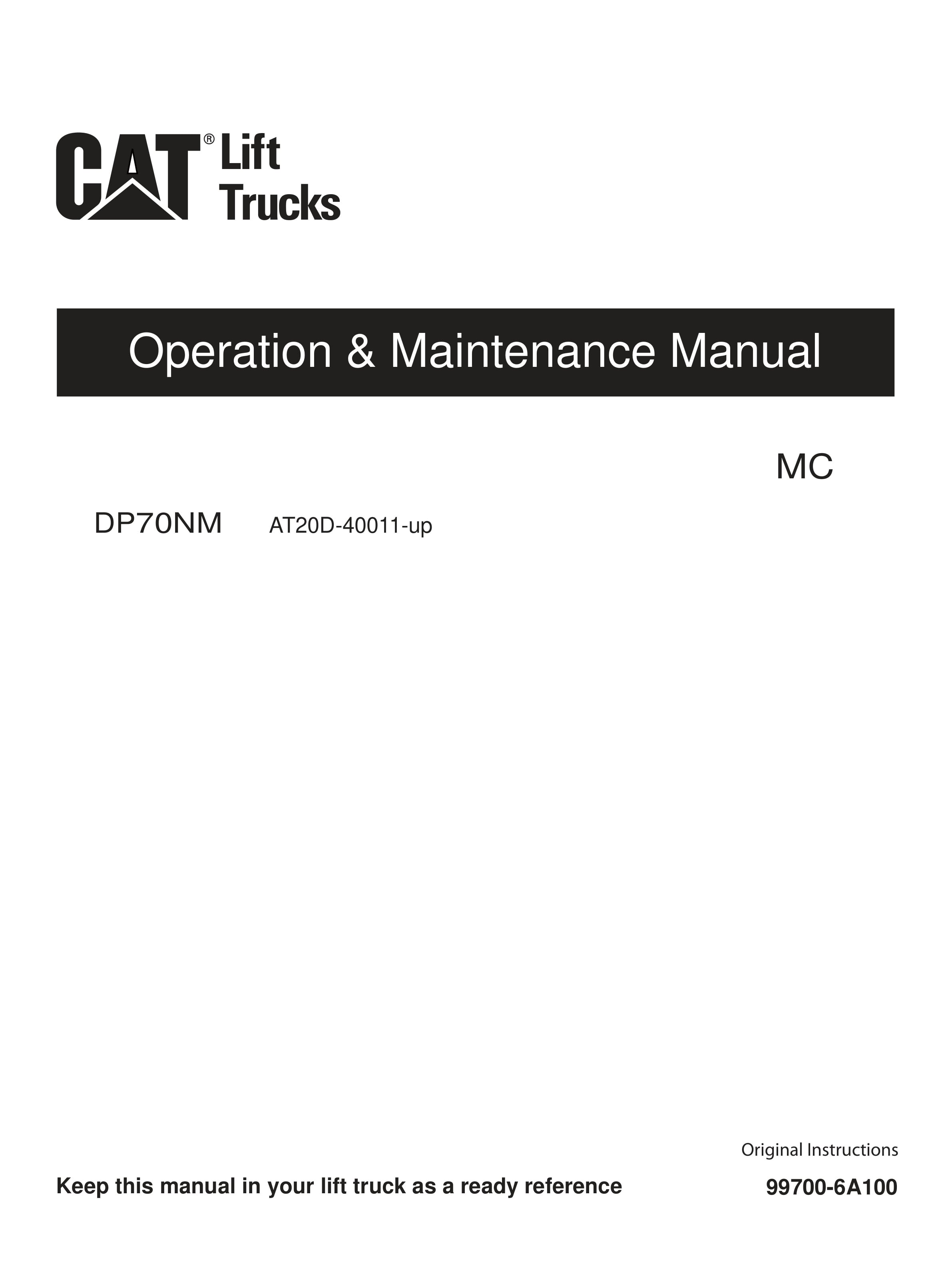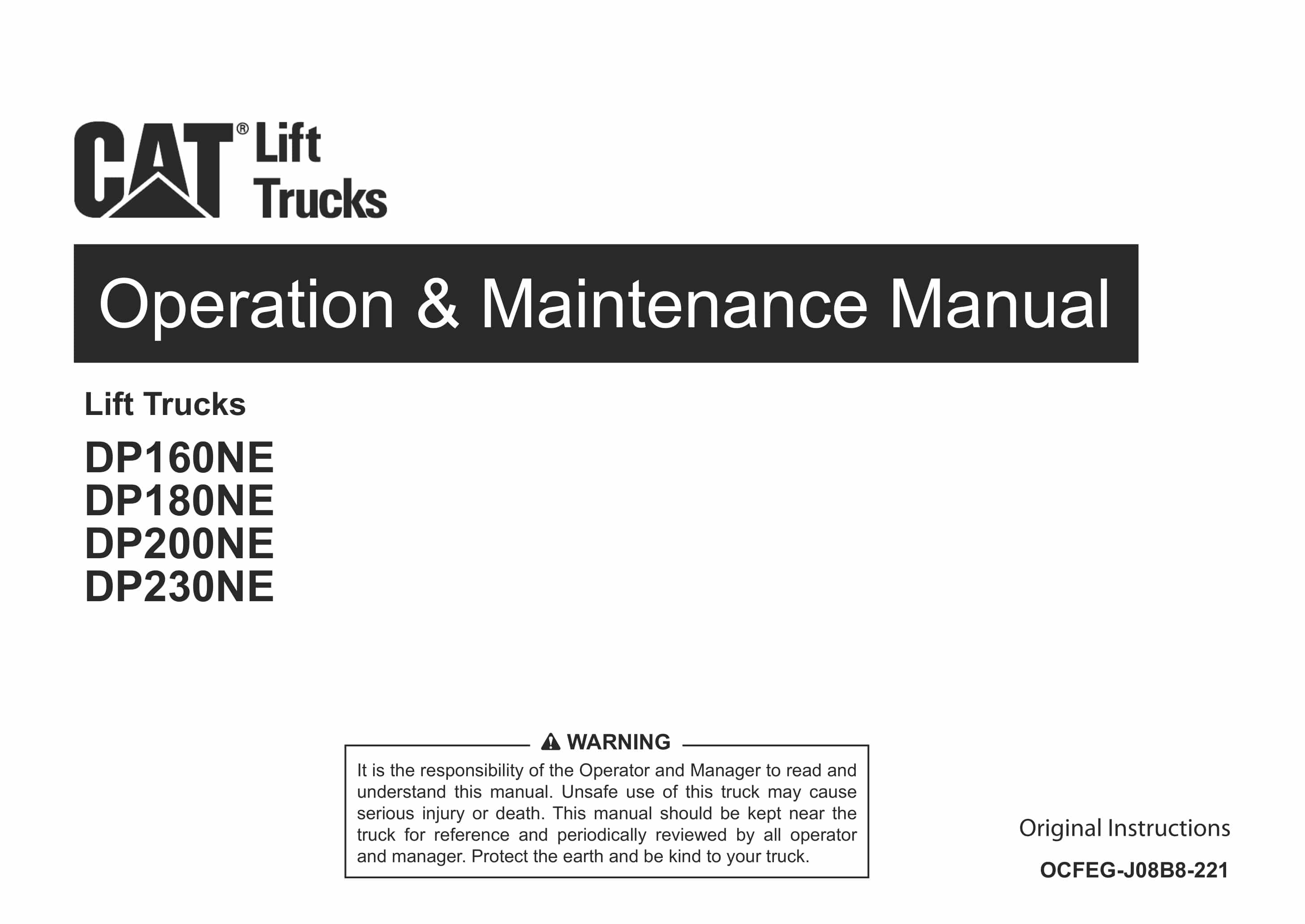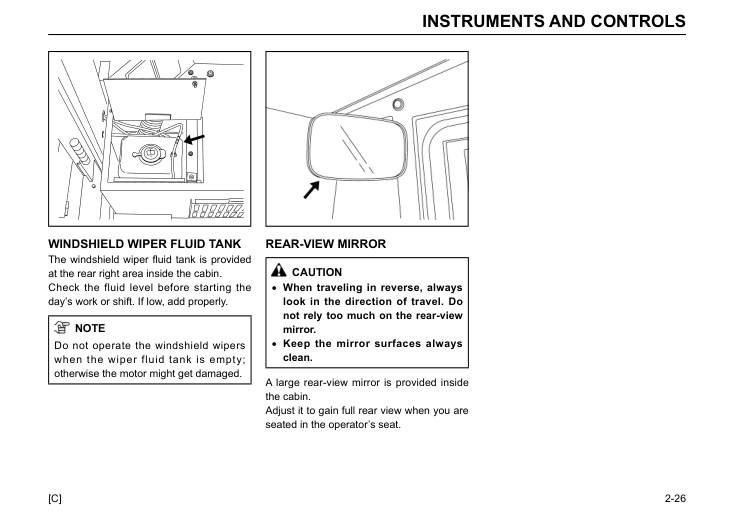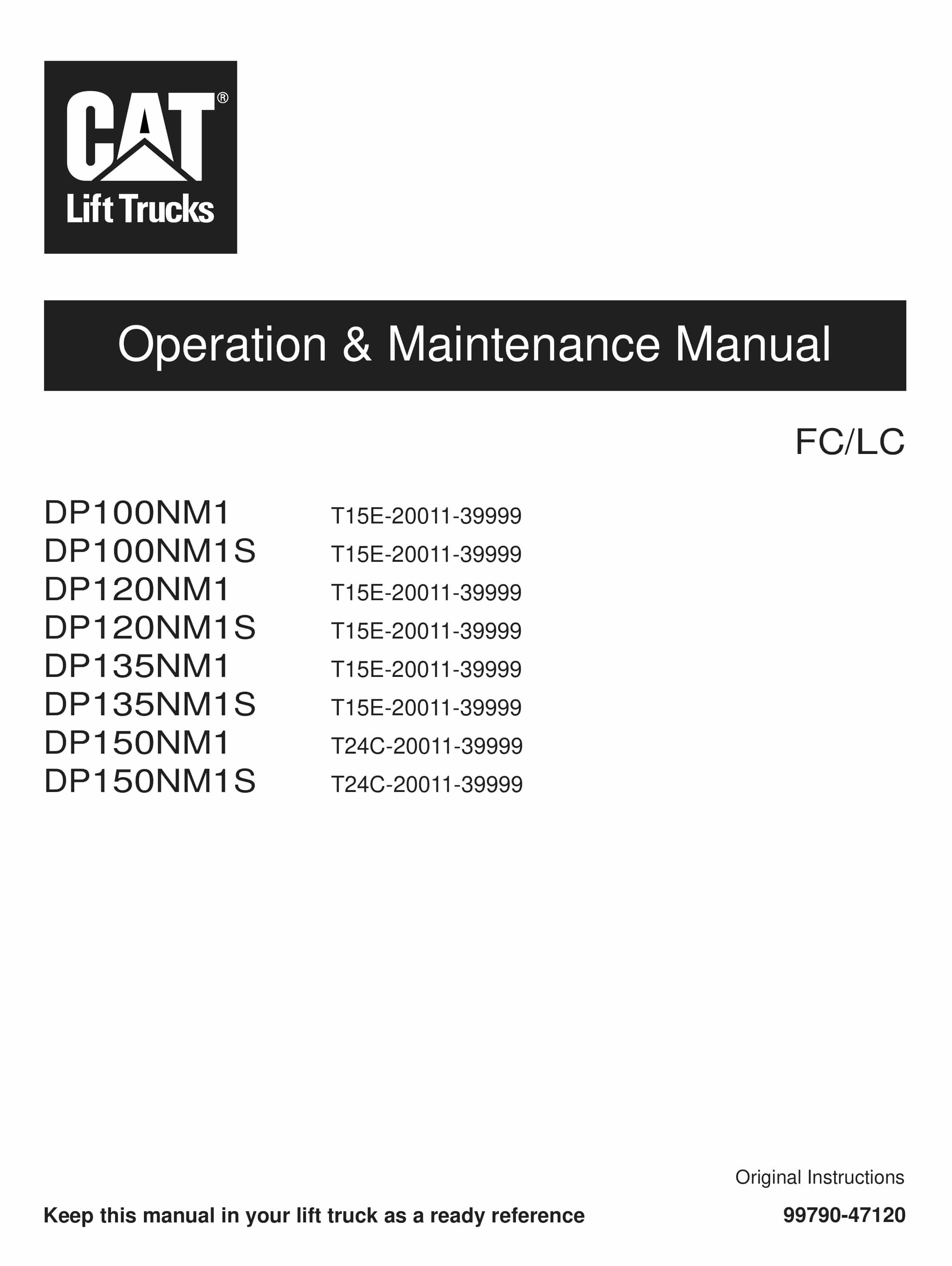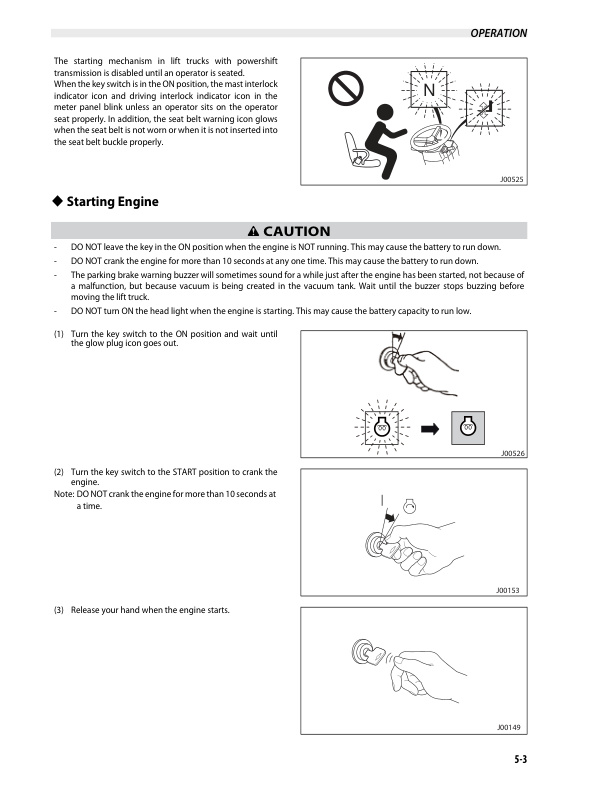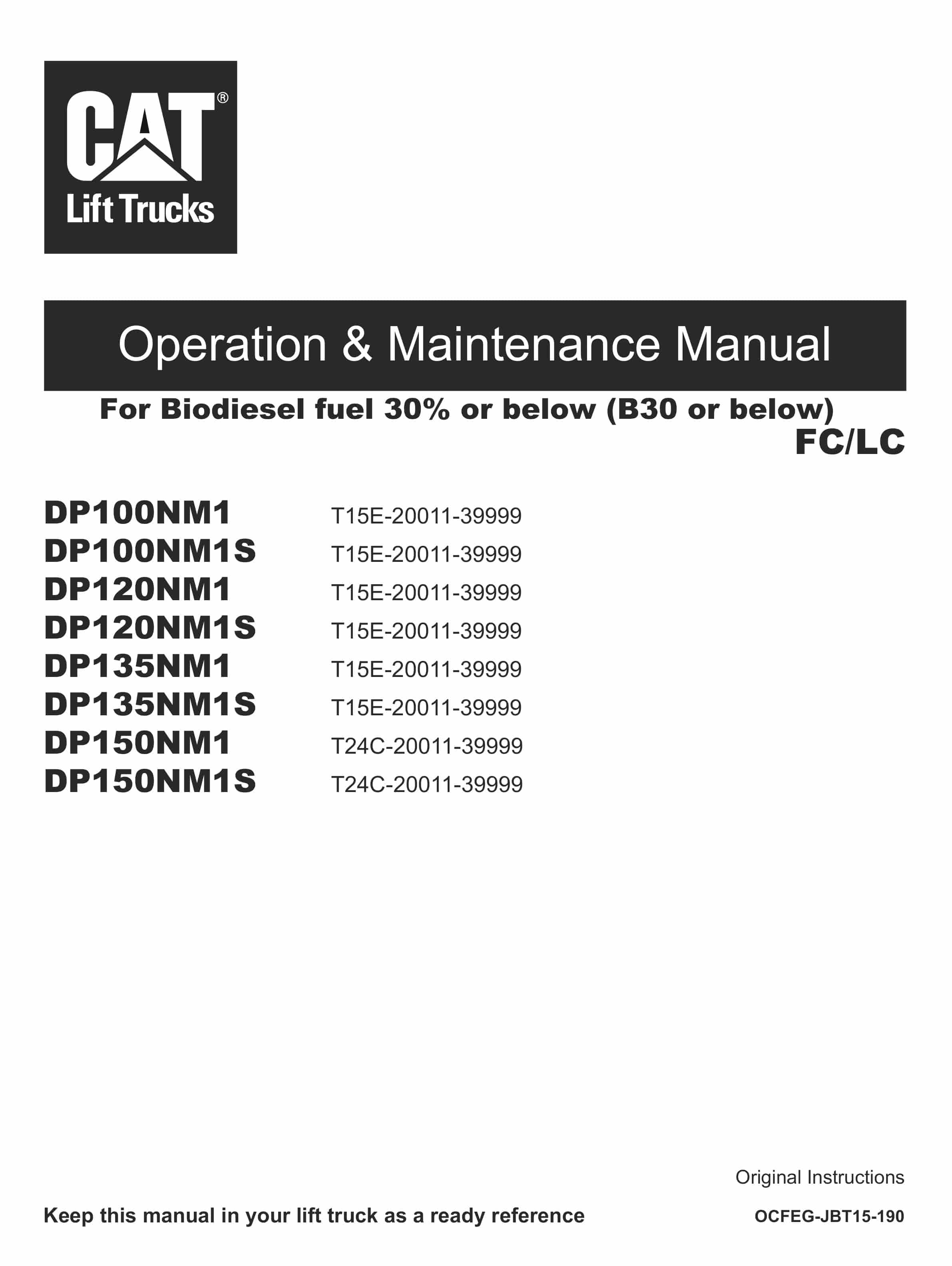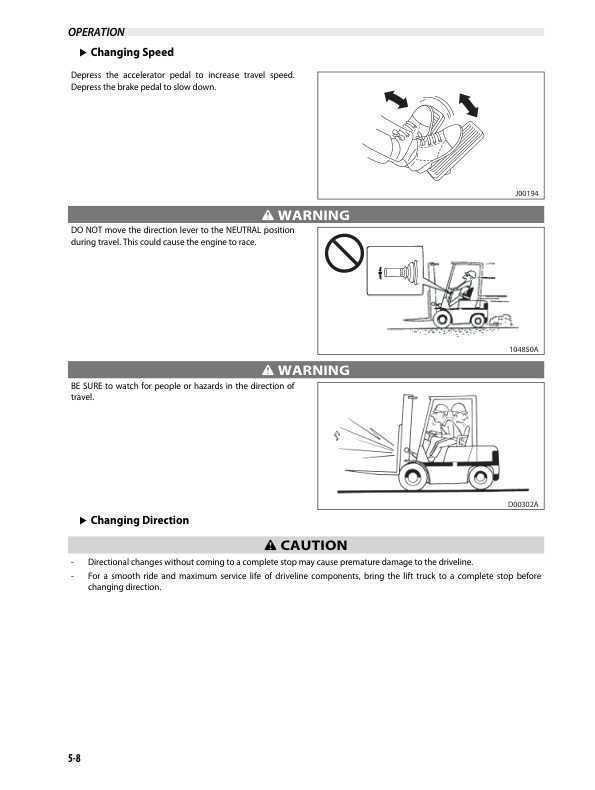Caterpillar GP20S-30S, DP20HS-30HS Operation and Maintenance Manual OCFEG-CT54E-230
$30.00
- Type Of Manual: Operation and Maintenance Manual
- Manual ID: OCFEG-CT54E-230
- Number of Pages: 198
- Size: 26.7MB
- Format: PDF
-
Model List:
- GP20S, GP25S, GP30S, DP20HS, DP25HS, DP30HS
- 1. OCFEG-CT54E-230_Front
- 2. OCFEG-CT54E-230
- 2.1. FOREWORD
- 2.1.1. How to Use This Manual
- 2.1.1.1. Truck Models Covered in This Manual
- 2.1.2. LOCKOUT/TAGOUT
- 2.2. SAFETY RULES FOR FORKLIFT OPERATORS
- 2.2.1. General
- 2.2.2. Warning Decals, Location
- 2.2.3. Warning Decals, Description
- 2.2.3.1. Survive in a Tipover Decal
- 2.2.3.2. Tipover Warnings
- 2.2.3.3. Operation Warning Decal
- 2.2.3.4. Hoist Point Decal (Mast)
- 2.2.3.5. Hoist Point Decal (Counterweight)
- 2.2.3.6. With Overhead Guard Decal / Load Backrest Extension
- 2.2.3.7. Fuel changeover instructions Decal
- 2.2.3.8. Parking Brake Adjustment Decal (Except for Australia)
- 2.2.3.9. Parking Brake Adjustment Decal (for Australia)
- 2.2.3.10. Cooling Fan
- 2.2.3.11. Radiator Cap
- 2.2.3.12. No One under / on Forks / Pinch Points
- 2.2.3.13. Crush and Pinch Points
- 2.2.3.14. Capacity Plate
- 2.2.3.15. No Riders Warning Decal
- 2.2.3.16. Engine Coolant Decal
- 2.2.3.17. Deflate Air Before Loosening Nut Decal
- 2.2.3.18. No Contamination Permissible Decal
- 2.2.4. Safety Rules
- 2.2.5. Operating Precautions
- 2.2.6. Working Precautions
- 2.3. KNOW YOUR FORKLIFT
- 2.3.1. Serial Number and Capacity Plate
- 2.3.2. Model View
- 2.3.2.1. MC Model
- 2.3.3. Driving Switches and Controls
- 2.3.3.1. Direction Lever
- 2.3.3.2. Turn Signal / Light Switch
- 2.3.3.3. Key Switch
- 2.3.3.4. Steering Column Tilt Lever
- 2.3.3.5. Inching Pedal
- 2.3.4. Meter Panel
- 2.3.4.1. Warning and Indicator Icons
- 2.3.4.2. Warning Icons and Indicators
- 2.3.4.3. Basic Screen Display
- 2.3.5. Operating Controls
- 2.3.5.1. Lift Lever
- 2.3.5.2. Tilt Lever
- 2.3.6. Travel and Load Handling Interlock System (for Australia)
- 2.3.6.1. Interlock operation
- 2.3.6.2. Releasing interlocks
- 2.3.7. Seat Belt Interlock (for Australia)
- 2.3.7.1. Seat belt interlock operation
- 2.3.7.2. Releasing the seat belt interlock
- 2.3.8. Operator Seat (for Australia)
- 2.3.8.1. Seat Adjustment
- 2.3.8.2. Forward and Back Adjustment
- 2.3.8.3. Adjustment of Suspension
- 2.3.8.4. Reclining Angle Adjustment
- 2.3.8.5. Pocket for the Manual
- 2.3.8.6. Magazine Box
- 2.3.8.7. Operator Presence Switch and Buzzer
- 2.3.9. Seat Belt (for Australia)
- 2.3.10. Operator Seat (Except for Australia)
- 2.3.10.1. Seat Adjustment
- 2.3.10.2. Forward and Back Adjustment
- 2.3.10.3. Reclining Angle Adjustment
- 2.3.10.4. Pocket for the Manual
- 2.3.11. Seat Belt (Except for Australia)
- 2.3.12. Engine Hood
- 2.3.12.1. Hood Latch
- 2.3.13. Drawbar Pin (Option)
- 2.4. HOW TO AVOID A TIPOVER HOW TO SURVIVE ONE
- 2.4.1. Know What Forklift Stability Is
- 2.4.2. Center of Gravity (CG)
- 2.4.3. Stability and Center of Gravity
- 2.4.4. Forklift Stability Base
- 2.4.5. Capacity (Weight and Load Center)
- 2.4.6. Capacity Plate
- 2.4.6.1. For Example
- 2.4.7. Dos and Donts to Avoid Tipover
- 2.4.8. How to Survive in a Tipover
- 2.5. REFUELING
- 2.5.1. Gasoline and Diesel Engine Equipped
- 2.5.2. LPG Equipped
- 2.5.2.1. For Standard LPG Tank
- 2.6. OPERATION
- 2.6.1. New Forklift Break-in
- 2.6.2. Before Starting Engine
- 2.6.2.1. Assist Grip
- 2.6.2.2. Starting Engine
- 2.6.2.3. Gasoline / LPG Dual Fuel Type
- 2.6.2.4. Instruction for Changeover of Fuel Between LPG and Gasoline
- 2.6.3. Starting Engine
- 2.6.3.1. Gasoline Model
- 2.6.3.2. LPG Model
- 2.6.3.3. Diesel Engine Model
- 2.6.4. Engine Wont Start
- 2.6.4.1. When Engine Is Flooded
- 2.6.4.2. When Engine Is Started after Long Idle Period
- 2.6.5. After Starting Engine
- 2.6.6. Before Moving Forklift
- 2.6.7. Forklift Operation
- 2.6.7.1. Changing Speed
- 2.6.7.2. Changing Direction
- 2.6.7.3. Operating Techniques
- 2.6.7.4. Steering (Turning)
- 2.6.7.5. Inching
- 2.6.8. Stopping Forklift
- 2.6.9. Parking Forklift (After Stopping)
- 2.7. OPERATING TECHNIQUES
- 2.7.1. Stacking Methods
- 2.7.1.1. Stacking Different Loads in Size
- 2.7.1.2. Stacking Small Identical Loads
- 2.7.1.3. Stacking Large Identical Loads
- 2.7.2. Handling Loads Safely
- 2.7.2.1. Fork Spread Adjustment
- 2.7.3. Inching Into and Lifting the Load
- 2.7.4. Traveling with the Load
- 2.7.5. Unloading
- 2.7.6. Working on Grades
- 2.7.6.1. Normal Travel Position
- 2.7.6.2. Traveling on a Grade
- 2.7.6.3. Stopping on a Grade
- 2.7.6.4. Starting on a Grade (Engine Stalls on a Grade)
- 2.8. STORING THE FORKLIFT
- 2.8.1. End of Each Shift Storage
- 2.8.2. Long Term Storage
- 2.8.2.1. Storage within 3 Months
- 2.8.2.2. Storage Exceeding 3 Months
- 2.9. TRANSPORTATION HINTS
- 2.9.1. Forklift Loading and Shipping
- 2.9.2. Lifting Your Forklift
- 2.9.3. Lifting Position
- 2.10. SPECIAL SITUATIONS
- 2.10.1. Care in Cold Weather
- 2.10.1.1. Fuel Oils and Lubrication Oils
- 2.10.1.2. Battery
- 2.10.1.3. Engine Coolant
- 2.10.2. Care in Hot Weather
- 2.10.2.1. Fuel Oils and Lubrication Oils
- 2.10.2.2. Battery
- 2.10.2.3. Engine Coolant
- 2.10.3. Severe Dust or Lint Conditions
- 2.10.3.1. Air Cleaner Element
- 2.10.3.2. Engine Oil and Engine Oil Filter
- 2.10.3.3. Hydraulic Oil
- 2.10.3.4. Hydraulic Tank Return Filter
- 2.11. TROUBLESHOOTING
- 2.11.1. If a Tire Blows Out
- 2.11.1.1. If a Tire Blows out During Traveling or Operation
- 2.11.2. Replacing Tires
- 2.11.2.1. Before Replacing Tires
- 2.11.2.2. To Remove Wheel
- 2.11.2.3. To Raise Front Wheel
- 2.11.2.4. To Raise Rear Wheel
- 2.11.2.5. To Install Wheel
- 2.11.2.6. To Add Air to Tires
- 2.11.3. Stalled Engine
- 2.11.3.1. Before Starting the Engine Again
- 2.11.4. If the Water Temperature Warning Icon Glows
- 2.11.5. Trouble with the LPG Equipment
- 2.11.6. Starting with Jumper Cables
- 2.11.7. If Lights Wont Glow
- 2.11.7.1. How to Check Fuses and Lights
- 2.11.8. If the Forklift Wont Change Directions
- 2.11.9. If the Mast Stops Moving
- 2.12. MAINTENANCE
- 2.12.1. General
- 2.12.2. Inspection Precautions
- 2.12.3. Maintenance Schedule
- 2.12.3.1. Every 10 Service Hours or Daily (Pre-Start), Whichever Comes First
- 2.12.3.2. Every 50 Service Hours or Weekly, Whichever Comes First
- 2.12.3.3. One Month (30 days) or 200 Service Hours after Delivery of a New Truck, Whichever Comes First
- 2.12.3.4. Every 500 Service Hours or 3 Months, Whichever Comes First
- 2.12.3.5. Every 1000 Service Hours or 6 Months, Whichever Comes First
- 2.12.3.6. Every 2000 Service Hours or 1 year, Whichever Comes First
- 2.12.4. Every 10 Service Hours or Daily (Pre-Start), Whichever Comes First
- 2.12.4.1. Faulty Operation Found the Day Before
- 2.12.4.2. Oil, Fuel or Coolant Leaks
- 2.12.4.3. Fuel Cap
- 2.12.4.4. Tires and Rims
- 2.12.4.5. Wheel Nuts
- 2.12.4.6. Tire Pressure
- 2.12.4.7. Lights and Lens
- 2.12.4.8. Assist Grip
- 2.12.4.9. Overhead Guard
- 2.12.4.10. Mast and Forks
- 2.12.4.11. Load Backrest Extension
- 2.12.4.12. Lift Chains
- 2.12.4.13. Mast and Lift Bracket
- 2.12.4.14. Lift Cylinder Mounting Bolts
- 2.12.4.15. Tilt Cylinder Socket Bolts
- 2.12.4.16. Lift and Tilt Cylinder
- 2.12.4.17. Battery
- 2.12.4.18. Engine Coolant
- 2.12.4.19. Engine Oil
- 2.12.4.20. Engine Cooling Fan
- 2.12.4.21. Transmission
- 2.12.4.22. Electrical Wires
- 2.12.4.23. Hydraulic Oil
- 2.12.4.24. Operator Seat
- 2.12.4.25. Steering Column
- 2.12.4.26. Steering Wheel
- 2.12.4.27. Service Brakes
- 2.12.4.28. Parking Brake Lever (Except for Australia)
- 2.12.4.29. Parking Brake Lever (for Australia)
- 2.12.4.30. Brake Pedal
- 2.12.4.31. Inching Pedal
- 2.12.4.32. Accelerator Pedal
- 2.12.4.33. Seat Belt
- 2.12.4.34. Head Light and Working Light
- 2.12.4.35. Turn Signal Light
- 2.12.4.36. Stop Lights (Option)
- 2.12.4.37. Backup Lights (Option)
- 2.12.4.38. Icons of Meter Panel
- 2.12.4.39. Meter Panel
- 2.12.4.40. Engine (Exhaust, Noise, and Vibration)
- 2.12.4.41. Mast Strip Sliding Surfaces
- 2.12.4.42. Brake Pedal
- 2.12.4.43. Parking Brake Warning Buzzer (for Australia)
- 2.12.4.44. Steering Wheel
- 2.12.4.45. After the Daily (Pre-Start) Inspection
- 2.12.5. Every 50 Service Hours or Weekly, Whichever Comes First
- 2.12.5.1. Brake Hoses, Pipes, and Joints
- 2.12.5.2. Fan Alternator Drive Belt
- 2.12.5.3. Hydraulic Hoses, Pipes, and Joints
- 2.12.5.4. Air Cleaner Element
- 2.12.6. One Month (30 days) or 200 Service Hours after Delivery of a New Truck, Whichever Comes First
- 2.12.6.1. Radiator Filler Cap
- 2.12.6.2. Radiator Rubber Hose
- 2.12.6.3. Alternator
- 2.12.6.4. Starter
- 2.12.6.5. Cylinder Head Bolt Manifold Nut
- 2.12.6.6. Electrical Wires
- 2.12.6.7. Intake Exhaust Valve
- 2.12.6.8. Engine Oil
- 2.12.6.9. Bolts and Nuts (Frame Chassis)
- 2.12.6.10. Fuel Filter (Diesel Model)
- 2.12.6.11. Fuel Filter (Gasoline Model)
- 2.12.6.12. Hydraulic Tank Return Oil Filter
- 2.12.6.13. Mast Support
- 2.12.6.14. Tilt Socket Pins
- 2.12.6.15. King Pins
- 2.12.6.16. Tie Rod Pins
- 2.12.7. Every 500 Service Hours or 3 Months, Whichever Comes First
- 2.12.7.1. Radiator Fin
- 2.12.7.2. Battery
- 2.12.7.3. Engine Idle Speed (for G/L dual engine)
- 2.12.7.4. Engine Oil
- 2.12.7.5. Bolts, Nuts (Frame Chassis)
- 2.12.7.6. Tar in Vaporizer
- 2.12.7.7. Fuel Filter (LPG Model)
- 2.12.7.8. Spark Plug
- 2.12.7.9. Lift Chains
- 2.12.7.10. Mast Support
- 2.12.7.11. Tilt Socket Pins
- 2.12.7.12. Mounting Bush of Rear Axle
- 2.12.7.13. King Pins
- 2.12.7.14. Tie Rod Pins
- 2.12.7.15. Differential
- 2.12.8. Every 1000 Service Hours or 6 Months, Whichever Comes First
- 2.12.8.1. Alternator
- 2.12.8.2. Starter
- 2.12.8.3. Cylinder Head Bolt Manifold Nut
- 2.12.8.4. Fuel Filter (Diesel Model)
- 2.12.8.5. Fuel Filter (Gasoline Model)
- 2.12.8.6. Hydraulic System
- 2.12.8.7. Air Cleaner Element
- 2.12.8.8. Powershift Transmission
- 2.12.8.9. Differential
- 2.12.9. Every 2000 Service Hours or 1 Year, Whichever Comes First
- 2.12.9.1. Service Brake Fluid
- 2.12.9.2. Engine Coolant
- 2.12.9.3. Fuel Filter (LPG Model)
- 2.12.9.4. Hydraulic Oil
- 2.12.9.5. Parts to Be Changed Periodically
- 2.13. SERVICE DATA
- 2.13.1. Fuel Information
- 2.13.1.1. Gasoline (Gas) Specification
- 2.13.1.2. Diesel Fuel Specifications
- 2.13.1.3. Liquefied Petroleum (LPG Model)
- 2.13.2. Coolant Information
- 2.13.2.1. Coolant Water
- 2.13.2.2. Antifreeze Solution
- 2.13.3. Recommended Fuels and Oils
- 2.13.4. Specifications (Standard Models)
- 2.13.5. Refill Capacities
- 2.13.6. Capacities and Forklift Weight (Standard Models)
- 2.14. TO THE TOWMOTOR FORKLIFT OWNER
- 2.14.1. The Importance of Genuine Parts
- 2.14.2. Instructions for Ordering Parts
- 2.14.3. Service Registration
- 3. OCFEG-CT54E-230_Back
Caterpillar Operation Manual PDF
Caterpillar DP70NH, DP80NH, DP100NH Operation and Maintenance Manual 99700-40100
Caterpillar Operation Manual PDF
Caterpillar DP60NM, DP60NMS, DP70NM, DP70NMS Operation and Maintenance Manual 99700-27110
Caterpillar Operation Manual PDF
Caterpillar DP100NZ, DP120NZ, DP135NZ, DP150NZ Operation and Maintenance Manual 99790-41000
Caterpillar Operation Manual PDF
Caterpillar DP70N Operation and Maintenance Manual 99700-30100
Caterpillar Operation Manual PDF
Caterpillar DP70E Operation and Maintenance Manual 99700-81120
Caterpillar Operation Manual PDF
Caterpillar DP100N1, DP120N1, DP135N1, DP150N1, DP160N1 Operation and Maintenance Manual 99790-42010
Caterpillar Operation Manual PDF
Caterpillar DP70NM Operation and Maintenance Manual 99700-6A100
Caterpillar Operation Manual PDF
Caterpillar DP160NE-230NE Lift Trucks Operation and Maintenance Manual OCFEG-J08B8-221
Caterpillar Operation Manual PDF
Caterpillar DP100NM1 to DP150NM1S Operation and Maintenance Manual 99790-47120
Caterpillar Operation Manual PDF
Caterpillar DP100NM1 to DP150NM1S Operation and Maintenance Manual OCFEG-JBT15-190
